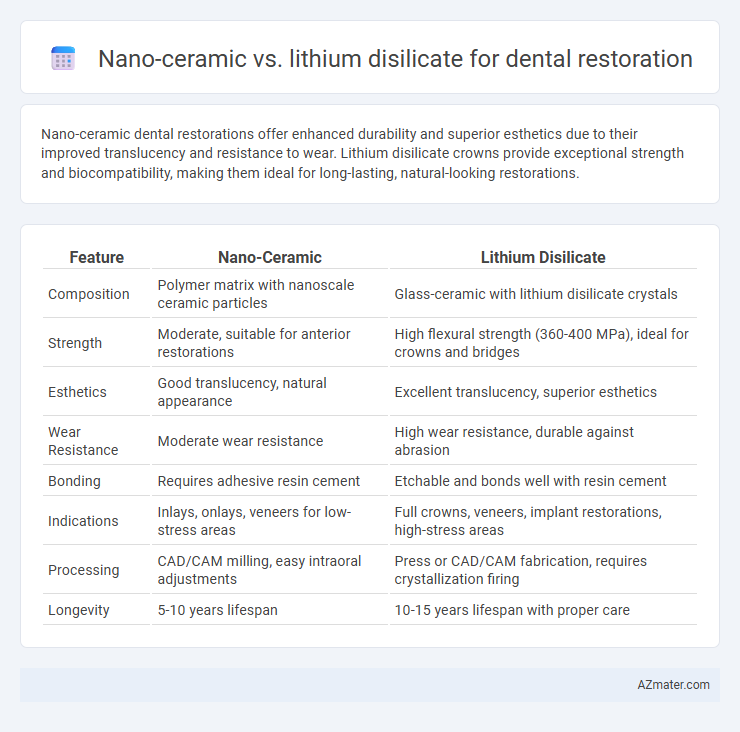Nano-ceramic dental restorations offer enhanced durability and superior esthetics due to their improved translucency and resistance to wear. Lithium disilicate crowns provide exceptional strength and biocompatibility, making them ideal for long-lasting, natural-looking restorations.
Table of Comparison
| Feature | Nano-Ceramic | Lithium Disilicate |
|---|---|---|
| Composition | Polymer matrix with nanoscale ceramic particles | Glass-ceramic with lithium disilicate crystals |
| Strength | Moderate, suitable for anterior restorations | High flexural strength (360-400 MPa), ideal for crowns and bridges |
| Esthetics | Good translucency, natural appearance | Excellent translucency, superior esthetics |
| Wear Resistance | Moderate wear resistance | High wear resistance, durable against abrasion |
| Bonding | Requires adhesive resin cement | Etchable and bonds well with resin cement |
| Indications | Inlays, onlays, veneers for low-stress areas | Full crowns, veneers, implant restorations, high-stress areas |
| Processing | CAD/CAM milling, easy intraoral adjustments | Press or CAD/CAM fabrication, requires crystallization firing |
| Longevity | 5-10 years lifespan | 10-15 years lifespan with proper care |
Introduction to Dental Restorative Materials
Nano-ceramic and lithium disilicate are prominent dental restorative materials known for their distinct compositions and clinical applications. Nano-ceramics combine resin and ceramic particles to offer enhanced aesthetics and flexibility, making them suitable for minimally invasive restorations. Lithium disilicate, a glass-ceramic, provides superior strength and translucency, ideal for crowns, bridges, and veneers requiring durability and lifelike appearance.
What is Nano-Ceramic?
Nano-ceramic for dental restoration consists of nanoparticles embedded within a ceramic matrix, offering enhanced strength, wear resistance, and excellent aesthetics that closely mimic natural tooth enamel. These materials combine the durability of ceramics with the flexibility and polishability of composites, making them ideal for veneers, crowns, and inlays. Nano-ceramic restorations exhibit superior translucency and color stability compared to traditional composites, contributing to long-lasting and visually appealing dental repairs.
What is Lithium Disilicate?
Lithium disilicate is a high-strength glass ceramic widely used in dental restorations for its exceptional esthetics and durability. Its fine microstructure allows superior translucency and natural tooth-like appearance, making it ideal for crowns, veneers, and bridges. Compared to nano-ceramic materials, lithium disilicate offers enhanced fracture resistance and long-term clinical success.
Mechanical Properties Comparison
Nano-ceramic materials in dental restorations exhibit high fracture toughness and excellent wear resistance, making them suitable for stress-bearing areas. Lithium disilicate demonstrates superior flexural strength, often exceeding 400 MPa, combined with enhanced translucency and durability in clinical settings. Both materials offer robust mechanical properties, but lithium disilicate's strength and esthetics frequently make it the preferred choice for anterior and posterior restorations.
Esthetic Advantages: Nano-Ceramic vs Lithium Disilicate
Nano-ceramic dental restorations offer superior esthetic advantages due to their enhanced translucency and natural light diffusion, closely mimicking the appearance of natural tooth enamel. Lithium disilicate provides excellent esthetics with high strength and a glassy surface, but may lack the same level of lifelike translucency found in nano-ceramics. The choice between nano-ceramic and lithium disilicate often depends on the specific esthetic requirements and the location of the restoration in the mouth.
Longevity and Durability of Restorations
Nano-ceramic dental restorations offer excellent durability with high resistance to wear and fracture due to their fine particle size and flexible resin matrix, promoting longevity in moderate stress areas. Lithium disilicate ceramics exhibit superior longevity in high-stress posterior restorations, attributed to their dense crystalline structure and exceptional flexural strength, often exceeding 400 MPa. Studies consistently demonstrate lithium disilicate's enhanced fracture toughness and fatigue resistance, making it the preferred material for long-lasting, durable dental restorations in load-bearing regions.
Indications and Clinical Applications
Nano-ceramic materials in dental restorations are primarily indicated for anterior and posterior crowns, veneers, and inlays due to their superior polishability, esthetics, and resistance to wear. Lithium disilicate is favored for full-coverage crowns, bridges, and implant-supported restorations thanks to its high flexural strength (around 360-400 MPa) and excellent translucency, making it ideal for both esthetic and functional demands. Clinical applications of nano-ceramic restorations benefit from minimal tooth reduction and ease of repair, while lithium disilicate offers enhanced durability in load-bearing areas and is suitable for adhesive bonding techniques in complex restorative cases.
Ease of Fabrication and Workflow
Nano-ceramic restorations offer easier fabrication with enhanced machinability and reduced brittleness, allowing for efficient CAD/CAM milling processes and shorter chairside times. Lithium disilicate provides superior esthetics and strength but requires more precise handling and longer firing times, impacting overall workflow efficiency. Choosing between these materials depends on the balance between streamlined fabrication and optimal mechanical properties for durable dental restorations.
Cost-effectiveness and Accessibility
Nano-ceramic dental restorations offer a cost-effective solution with materials generally priced lower than lithium disilicate, making them more accessible for patients with budget constraints. Lithium disilicate provides superior strength and esthetics but often comes with higher laboratory fees and longer processing times, which can increase overall treatment costs. The accessibility of nano-ceramic options is enhanced by faster chair-side fabrication and simpler bonding techniques, benefiting clinics with limited resources or those seeking quicker turnaround.
Patient Satisfaction and Clinical Outcomes
Nano-ceramic restorations offer enhanced aesthetics and superior wear resistance, leading to high patient satisfaction due to their natural translucency and comfort. Lithium disilicate is renowned for its exceptional strength and durability, providing reliable long-term clinical outcomes, especially in anterior and posterior restorations. Comparative studies indicate that while both materials yield favorable patient satisfaction, lithium disilicate demonstrates slightly better longevity under functional stress.

Infographic: Nano-ceramic vs Lithium disilicate for Dental restoration
 azmater.com
azmater.com